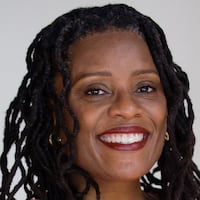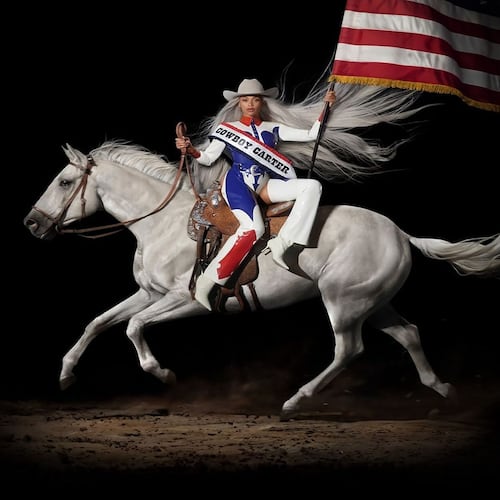EVENT PREVIEW
"Romare Bearden: A Black Odyssey." Through March 9. 10 a.m.-4 p.m. Tuesdays-Fridays; 10 a.m.-5 p.m. Saturdays; noon-5 p.m. Sundays. Closed Mondays and Dec. 24-25, Dec. 31-Jan. 1. Guided tours 2 p.m. Sundays. $8 adults; $6 students, seniors, children 17-6; children 5 and younger free. Michael C. Carlos Museum of Emory University, 571 S. Kilgo Circle, Atlanta. 404-727-4282, www.carlos.emory.edu
Upcoming events:
"Drawing Us Together: Bearden, Homer and the Tradition of the Improviser." Robert O'Meally, curator of "Romare Bearden: A Black Odyssey," lectures. 7:30 p.m., Jan. 14, free, Carlos Museum Reception Hall, 3rd floor.
"Live Reading of Homer's 'Odyssey.'" A three-day, live reading of Stanley Lombardo's translation of Homer's epic. Reader's include actor Chris Kayser, actor Tom Key, former Atlanta Mayor Shirley Franklin and TV news anchors Jovita Moore and Valerie Jackson. Books 1-8, 7 p.m., Jan. 24; Books 9-16, 7 p.m., Jan. 25; Books 17-24, 2 p.m., Jan. 26. Free. Carlos Museum Reception Hall, 3rd floor. www.carlos.emory.edu.
"Artful Stories." A collage workshop and reading of "My Hands Sing the Blues" for children ages 3-5. 10 a.m. Feb. 8. Free, but registration is required. Carlos Museum, 3rd floor. 404-727-0519.
On any given Saturday afternoon, toward the later years of his life, Romare Bearden’s favorite spot was a seat at the Strand Bookstore in New York City.
Voracious didn’t begin to describe his literary appetite. He was an anything-you-can-get-your-hands-on reader, whether it was fiction, poetry, philosophy or the work of Bearden’s good friend, Ralph Ellison. The stacks at the Strand held both inspiration and comfort.
“He was trying to see things he could use and import into his own aesthetic vocabulary,” said Robert O’Meally, a Columbia University professor who’d sometimes accompany Bearden on those haunts.
Jazz is usually the first association people make regarding the lyrical collages that defined the latter half of Romare Bearden’s career and propelled him to international acclaim. But literature inspired the 20th century’s greatest collagist from the start, as is evidenced in the nearly 60 works in “Romare Bearden: A Black Odyssey” at Emory’s Michael C. Carlos Museum.
The show, which was originally mounted in 1977, is Bearden’s interpretation of Homer’s epic poem, “The Odyssey.” Mostly collages, the nearly 60 works begin with the Fall of Troy and conclude with Odysseus’ reunion with his wife Penelope. Also included in the exhibition are line drawings and one of the watercolors Bearden did in the 1940s, based on Homer’s “The Iliad.” This show and it’s smaller companion show, “Southern Connections: Bearden in Atlanta,” which explores the artist’s longtime ties to the city, are on view through March 9.
Just as Biblical stories and players inspired the artist in the early part of his career — as in his depiction of the Passion of the Christ — so did his Southern roots and black heritage influence his rendering of those characters on canvas. Bearden, who died in 1988, was born in rural North Carolina and reared in black communities in Pittsburgh and Harlem, New York. He came of age in the midst of cultural and social movements, primarily The Great Migration of rural Southern blacks to the industrial North and the Harlem Renaissance with its nexus of eminent black writers, artists and thinkers. So the figures in his “Odyssey” had the features and body shapes of the people he grew up around.
“He loved the Cubist movement and you can see its influence in his work, but in the end Cubism was too square for him,” said O’Meally, who curated “A Black Odyssey.” “He wanted to find a way to make his figures rock on canvas.”
Looking at “The Siren’s Song” from the series, there is a palpable sway to the sirens’ thick, black and brown hips. The face of “Poseidon, the Sea God” and nemesis of Odysseus, has the full, strong features of sub-Saharan Africans. It wasn’t that the artist was trying to make the epic poem a black story, so much as he was trying to show that people of all races can relate to universal themes as intense as longing and events as traumatic as war.
About 20 years before Ed Spriggs became the founding director of Atlanta’s Hammonds House Museum (which loaned several Bearden works for this exhibition), he was a case worker for the department of welfare in New York City. So was Bearden. It was a job Bearden maintained for decades, even as he was creating some of his master works after hours.
Spriggs and Bearden met on the job and struck up an acquaintance that eventually led to Bearden becoming an advisor for the Studio Museum in Harlem of which Spriggs had become the director. Spriggs said the artist always displayed a sense of activism in his work as well as a conviction that black stories from the Deep South — of trains bearing you away from trouble, of baptisms in the pond behind the church — were pillars of the nation’s epic story.
Bearden, along with other artists including long-time associate and former Atlanta University professor Hale Woodruff, formed the Spiral art collective in the late 1960s to address the role of the artist in the civil rights movement.
“He got his activism from his mom because she was involved in politics and organizing in Harlem,” Spriggs said recently. “So he was vocal. But he also was an intellectual in his own right.”
He surrounded himself with other black intellects such as Ellison, Albert Murray, and the group would spend hours on weekends in bookstores and museums, debating the African American’s place within the nation’s identity, O’Meally said. He often accompanied them on those excursions for a book he was writing on Ellison.
“Bearden would pull out his portfolio of new work and Murray would help him title them and then Bearden would help him come up with a sentence,” O’Meally said. “There wasn’t a canvas big enough for his ambition. And for him the African-American story was among the greatest stories ever told.”
Yet for all of that, Bearden took issue with black artists who depicted black characters without trying to say something larger and more universal with them, O’Meally said. To do anything less was a missed opportunity to address shared humanity.
As if to punctuate that point, included in the overall show is an abstract, “Snow Morning.” Initially it is not recognizable as a Bearden, and though not the strongest offering in the show, it demonstrates the artistic range he displayed throughout his career.
Pointing to it, Randall Burkett, curator of African American Collections at Emory’s MARBL division of libraries, asked, “In what sense is that an African-American piece? You know, there’s always this tension between the whole and the part. What he does is what most great artists do, which is to pull from what you know best and present it as a quintessential experience.”
In the surrounding galleries, the artist’s response to that dilemma is stated boldly, in a journey from Troy to Ithaca told through brushstrokes, scissor cuts, and lines of black.
About the Author
Keep Reading
The Latest
Featured


